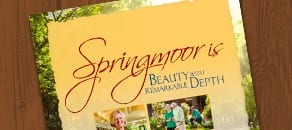By Thom Morgan, Springmoor landscape manager
Are you scratching your head, trying to figure out what gifts to give your friends and family for the holidays? You want to give them something that will brighten their spirits, and that might brighten their home—right? Carefully-selected plants can do wonders for the spirit and the landscape (inside and out). Consider shopping at your local nursery this holiday season. You just might end up walking out with a few festive treasures for yourself.

Thom Morgan
Before you get started, here’s the rundown on the most popular holiday selections:
Poinsettias: These are easily the most popular holiday plant. There are more than 100 varieties, and account for $140 million in sales in the United States. Poinsettias don’t have a long shelf life, and you have to work to keep them alive through the holidays; the lack of light and low humidity in homes and offices isn’t conducive to the plant, so enjoy them while they last. And if you are considering giving them as gifts, be mindful that the plants are mildly toxic to dogs and cats.
Amaryllis: These plants come in fire engine red, pink, peach and white. Then there are dwarf varieties and various flowers, which add up to about 50 varieties! For the experienced gardener on your list, Amaryllis can be bought as a bulb and forced to flower by watering frequently. Amaryllis can also be bought in bloom, and placed near a window during the holiday season. Here in the Piedmont of North Carolina, we can plant the spent bulbs in our gardens when the weather warms up. Don’t expect them to bloom next Christmas though; Amaryllis left outside bloom in July and August unless you dig them up and condition them indoors again.
Christmas Cactus: There are more than 60 varieties of this plant, and after you have had the plant for a few years, it will bloom at Thanksgiving or Easter as well. They last a long time if you don’t over water them, and they are very easy to take cuttings from and start new plants.
Live Christmas Trees: While you’re unlikely to get these as a gift for someone else, it’s important to have an understanding of the tree when you go to purchase one for your own home. Some nurseries and Christmas tree vendors sell live, balled and burlap evergreens to be brought indoors for Christmas trees. One problem with this is that Spruce and Fir do not tolerate our hot and humid Piedmont summers. Another problem is that the tree has to be conditioned from being in the cold outdoors for a week in a place like a garage, before bringing indoors. Then when it is ready to go back outside, it needs to go to the garage for a week, and then it can be planted. Eastern Red Cedars would be the best tree for our area if you want to try a live tree. Avoid the male tree especially if you have allergies. The warm temperatures in your house will cause the male trees to produce pollen, and nothing says Merry Christmas like a bunch of people sneezing. Female Eastern Red Cedars are grayish in color, have gray berries on them and present little problems. You still want to check your live tree, and even a cut tree for insect caccoons . Some large species of moths like to use the shelter of evergreens to lay their eggs, and Praying Mantis nests contain up to 200 larvae, which can hatch when indoors for a couple of weeks.
December Focal Points:
Hamamelis vernalis Vernal Witch Hazel are blooming now. The 70-degree temperatures we experienced recently have forced them out. We have three on our campus. Can you find them?
Camellia sasanqua Sasanqua Camellia are still blooming; they are planted throughout the campus.
Camellia japonica “Governor Mouton” Governor Mouton Japanese Camellia look like a large peppermint drop. This Japanese Camellia always blooms for us around Christmas. You can find them blooming now along the putting green side of the West Apartments.
Prunus Autumnalis Autumn Cherry are in bloom. I planted quite a few around the community. Look for them by the putting green and entrances.
Chaenomeles speciosa “Jet Trails” Jet trails Quince are just opening up along the bare branches of this quince.
Mahonia fortunei Chinese Mahonia are opening up among dark green leaf fronds. We have a few Chinese mahonia by the Tattoo Wolf.

Christmas Cactus
December Things to do:
Fertilize your fescue lawn to help see it through the winter.
Apply 10 10 10 or 8 8 8 fertilizer to your winter vegetables such as collards, cabbage, kale and broccoli.
Soil sample Now is a good time to take a soil sample around your flower beds, and vegetable gardens. Ph should be around 6 for most shrubs and vegetables.
Remove spent perennial stalks, and discard in the mulch pile.
Fall leaves: Even the oak trees should be bare by now, so collect the leaves for compost. If you have a mulching mower use it to vacuum up the leaves. Mulch mowers shred the leaves, which helps speed up the decaying process.



